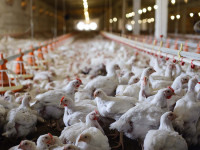Money
Industrial districts unable to propel private sector growth
Average industry capacity utilisation fell to 58.47 percent in third quarter of the fiscal year 2023-24, compared to 62.31 percent in the second quarter.
Post Report
Nepal has ten industrial districts, but the private sector has yet to reap the benefits, according to a recent report. Multiple challenges have been impeding the sector's ability to thrive.
According to the third quarter Industry Status Report for the fiscal year 2023-24 published by the Confederation of Nepalese Industries (CNI) recently, the major challenges faced by the private sector in industrial districts are inadequate infrastructure, regulatory constraints, lack of political commitment, access to the market, environmental concerns, and access to finance.
The government has not been able to develop new industrial estates in 36 years, the report said. “Industrial districts help to foster collaboration among businesses, improve efficiency, and contribute to regional economic development.”
Experts said that the government still needs to develop an industry strategy.
Economist Puskar Bajracharya said that most industrial estates cannot operate well due to labour disputes. For instance, many industries based at Balaju and Hetauda industrial estates were forced to quit operations.
The existing facilities, such as roads, drainage, and sewage, in the industrial estate are not maintained properly, which makes them less attractive to new investors.
Bajracharya said the management of industrial parks is important. For instance, CG Industrial Park, which is privately operated by the Chaudhary Group, can be a good example of managing an industrial estate.
The benefit of industrial estate is that the investment cost will be reduced, and industries will be automatically zoned, making it easy to manage environmental pollution. One of the reasons for foreign direct investment not coming into Nepal is high land prices, and industrial estate, too, failed to attract foreign investors, he said.
“Absence of political commitment has always been the issue for growth and development in the industrial sector. This is due to political instability in the country. It inspires frequent changes and policy amendments as well,” the report said.
The political status of the nation is one of the major environments for any business. Political instability creates uncertainties.
The report pointed out that balancing environmental conservation with industrial growth has always been a challenge due to stringent regulatory compliance.
According to the report, Rs75.66 billion has been invested in the ten industrial districts, of which the private sector has invested Rs20.30 billion.
Out of 706 industries in the industrial district, 642 are in operation, 45 are under construction, and 19 have already been closed. The industries in the industrial district have generated jobs for 18,366 people.
In addition to the ten, 17 industrial districts are either in the phase of detailed project report, a pre-feasibility study or planning for feasibility.
Nepal-China Friendship Industrial Park in Jhapa, Mayurdhapa in Makwanpur, Shaktikhor in Chitwan, Motipur in Rupandehi, Naubasta in Banke, and Daijichela in Kanchanpur are among industrial estates in different districts whose detailed project reports are being conducted.
Similarly, Murtiya (Sagarnath) in Sarlahi, Chyangip Hat in Gorkha, Laxmipur in Dang, Chaurase in Surkhet, and Lamki in the Kailali industrial area are under pre-feasibility study. The government is planning a pre-feasibility study in Rautahat, Tanahun, Jumla, Dailekh, and Chandani Dodhara in Kanchanpur.
According to the report, among quarterly surveys conducted in 61 industrial firms, the average industry capacity utilisation declined to 58.47 percent in the third quarter of the fiscal year 2023-24, compared to 62.31 percent in the second quarter of the same fiscal year.
The service industry capacity utilisation increased to 66.11 percent in the third quarter from 62.78 percent in the second quarter.
The capacity utilisation of the manufacturing industry declined to 52.03 percent from 61.97 percent during the review period.
“The monetary policy of last fiscal year increased the interest rate by 350 basis points to 8.5 percent to address the inflation, which caused the slowdown in economic activities,” said Bajracharya. “The upcoming monetary policy should address the ongoing economic slowdown.”
Similarly, the revenue of surveyed industries declined by 3.87 percent in the third quarter of the last fiscal year compared to a decline of 1.87 percent in the second quarter. The revenue growth of the manufacturing sector decreased to 13.14 percent from a decline of 6.71 percent during the review period.
According to the report, the demand for manufacturing industries has declined by 13.53 percent.
On average, 71.43 percent of the surveyed industries perceived their goods to be competitive in the market of imported goods, which gives optimism to domestic sectors.
The report said the confidence among domestic businesses regarding their competitiveness and sufficient market demand for domestic products is a critical factor for expanding a broader industrial base in Nepal.
The average proportion of exports from their production has decreased from 27.78 percent in the second quarter of the fiscal year 2023-24 to 25 percent in the third quarter of the same fiscal year. These findings suggest that firms must be more engaging in exporting their products. The overall share of exports is experiencing a decline, the report said.
The report also showed that the import of raw materials also declined to 35.58 percent from 41.44 percent during the review period.
The report's findings said that firms are not exporting their products as the overall share of exports is declining.
Similarly, 25 percent of the respondent manufacturing industries exported their goods.
The surveyed industries collectively hired 310 new staff members during the third quarter, while the number of applicants was 3,571.




 7.12°C Kathmandu
7.12°C Kathmandu












%20(1).jpg&w=300&height=200)
